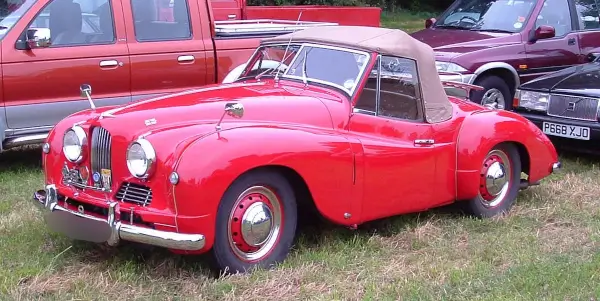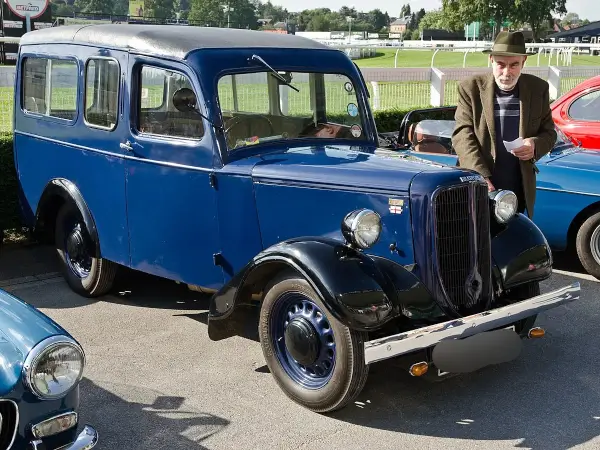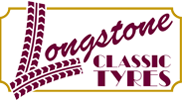Jowett Tyres
Classic Jowett Tyres

On the following pages, Longstone Classic Tyres give classic tyre fitment recommendations for Jowett cars.
01302 711 123
or
Email: sales@longstonetyres.co.uk
Jowett History
Benjamin (1877–1963) and William (1880–1965) Jowett established Jowett in 1901. Some early engines were used as replacements in other manufacturers of automobiles on a local level. In 1904 they renamed themselves the Jowett Motor Manufacturing Company and relocated to Back Burlington Street in Bradford. Their first Jowett light car was built in February 1906, but because their small workshop was so busy with general engineering activities, experimenting with different engine configurations, it did not go into production until 1910, and then only after more than 25,000 miles of rigorous testing.

Their goal was to offer a light car at a low cost and with minimal operating expenses. The prototype may be considered as the UK's first true light car. The engine and transmission were particularly built for a light automobile and were mostly constructed of aluminium. Its low-speed torque and gear ratios were suitable for the hills around Bradford and Yorkshire's topography, where bad roads made a high top speed or rapid acceleration useless. The engine and the rest of the automobile were built to last. It had a 6.4 hp water-cooled flat-twin engine and a three-speed transmission with tiller steering. The body was a two-seater open body that was lightweight and open. Jowett promoted their third automobile as having 8 horsepower with no changes to the specifications. When the First World War broke out, the plant was converted to armaments production.
Jowett Cars Limited was a new private company created in June 1919 to manufacture and sell motorcars, and it bought the vehicle manufacturing section of the Jowett Motor Manufacturing Company's operations. In 1935, it became a public corporation and was floated on the London Stock Exchange. In 1919, a new industrial site was purchased at Springfield, Bradford Road, Idle, outside Bradford, on the site of a defunct quarry. In 1920, the new plant began producing automobiles. The Jowett Seven, an extended version of the pre-war flat twin, was the first vehicle. It was first extended to 831 cc, then to 907 cc in 1921 when the 8 hp claim was eliminated from advertising. Until the advent of the four-cylinder engine in 1936, all Jowetts were Sevens. The engine produced its highest torque at low rpm and quickly became known for its pulling power, dependability, and efficiency.
Beginning in 1922, commercial vehicles based on automobile chassis were also produced, and they constituted an increasingly important element of the company's output. In 1923, coil ignition and electric starting were added, and the four-seater "Long Four" tourer, priced from £245, was released, followed in 1925 by a closed saloon model, with the preceding short-chassis two-seater remaining in production. To facilitate maintenance, the engine gained replaceable cylinder heads in 1929, and brakes were implemented on all four wheels. When a fire raged through the plant in September 1931, production was momentarily halted.
The Jowett Kestrel with a four-speed gearbox was introduced in 1933, while the curiously titled Jowett Weasel sports tourer was introduced in 1935. The 1166 cc twin carburettor Jowett Ten was the first four-cylinder (flat-four) car, introduced in 1936, and remained until the onset of war alongside the regular twin-cylinder versions, which rose to 946 cc in 1937. Benjamin Jowett retired in 1936 after the firm went public in 1935. Brother William continued until 1940. Car manufacture ceased in 1940, but engine production for motor-generator sets, as well as aircraft components and other military gear, remained. Charles Clore, a property developer, purchased the firm in 1945 and sold it to the financiers Lazard Brothers in 1947.
When production resumed after WWII, the twin-cylinder engine was dropped from the new car range, but continued in 1005 cc form until the end of production in commercial vehicles, which now included a light lorry, the Bradford van, two variants of an estate called the Utility, and chassis front-ends and kits for coachbuilders, many of whom were from abroad. The new automobiles were a radical departure from the sleek Jowett Javelin created by a team led by Gerald Palmer. A flat-four push-rod engine, independent front suspension with torsion bars front and rear were among the revolutionary features. The car had a maximum speed of 80 mph and outstanding handling. The Javelin was joined by the Jowett Jupiter sports vehicle in 1950. Jowett created javelins for manufacturing quantities never previously tried. Briggs Motor Bodies developed a new facility in Doncaster to manufacture Javelin and Bradford bodies.
Briggs provided the bodies fully trimmed and ready for installation on the mechanicals. Idle always constructed the Jupiters in-house. The new mechanicals experienced some growing pains, but Javelin bodies were nonetheless mass-produced according to the previous timetable, resulting in stockpiling. Export sales fell by 75% in 1952, followed by slow domestic sales as the country awaited the repeal of a "temporarily" higher purchase tax, which was ultimately lifted in April 1953, with terrible long-term ramifications for Jowett.
Poor corporate strategy and direction, as well as over-confidence, were the demise of the financially strong business, and even after the engine and gearbox difficulties were resolved, the Idle factory was neither able to manufacture, nor was the distribution network able to sell, the planned volume throughout 1952. The failure of the agreements for the delivery of bodies resulted in the halt of Javelin production in 1953, along with that of the now-outdated Bradford, despite the fact that tooling for future versions had been finished. Jupiters remained popular and were manufactured until the end of 1954. The firm did not go bankrupt, but it did sell its facility to International Harvester, who manufactured tractors there until the early 1980s.
In a disused woollen mill at Howden Clough, Birstall, near Batley, Jowett began producing aeroplane parts for the Blackburn & General Aircraft Company. Jowett, or the "shell" of the firm, was eventually taken over by Blackburn in 1956, while spares for postwar automobiles were kept accessible until 1963 when the remainder of the Jowett company was liquidated owing to aircraft industry streamlining.
